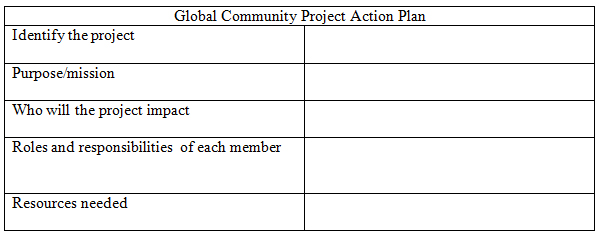This lesson begins with the read aloud of Something Beautiful by Sharon Wyeth which is a very touching and relevant story for inner-city learners. This story is about a young girl who looks beyond the ugliness of her inner-city neighborhood in order to find beauty in her life. She spends all day walking around and asking people that she knows if they have something beautiful until she realizes the beauty she is looking for is in her heart and in her control. In the end she goes home and cleans up her front yard and experiences the feeling of empowerment.
Objectives
Students will learn how they can have an impact on others globally through an act of volunteerism.
Students will learn to work collaboratively with project community members to reach a common goal.
1. Pre-reading: Bring in a vase of beautiful flowers or a bright painting and display them on top of a cluttered mess on a table. Ask the students to name what they see? Most students will respond to the beautiful vase of flowers or the bright painting. Ask the students who said the flowers or painting why they saw the flower or painting first. Tell the students that the girl in our book is having a hard time looking for something beautiful. Show the cover of the book and ask students to think-pair-share why they think she is having trouble. Allow students to share their thoughts and ideas and have them draw connections to their own lives.
2. Read Aloud: Read aloud the book and stop periodically to ask questions to check for understanding. Possible questions might be:
Why do you this the young girl is so determined on her quest to find something beautiful?
How would you describe the girl's feelings in the beginning of the story?
Do her feelings change throughout the story? How so?
Who did the girl make her yard beautiful for?
How do you think the girl feels after she cleaned up her yard?
What do you think the author is trying to tell us through the story?
How can we use this story to make things better in our world?
3. At the end of the story write the word philanthropy on the board. Define it for the students in kid friendly terms. Such as "a voluntary effort one takes to use their time, talent, or resources to benefit others." Explain to the class that just as a girl in the story, they also have power to impact change not just locally but around the world.
4. Using the computer overhead, display the website, http://collaborate.ilearn.org. Show the students several possible global projects they can join and become philanthropists. Explain that they will be interacting with others across the globe to have impact on a common cause or issue. Depending on skill level and computer access, allow students to research possible projects on their own.
5. Target about 10 projects that seem to peak the students interests. Allow students to form groups of 3 to 5 students to choose a project. In forming groups try to allow students to choose their top two projects. This will help in creating heterogeneous groups.
6. Students will then complete a plan of action form to identify their project, who and where will it have impact, resources needed, and roles of each member will perform.

Closure: Each group will share the project they will take part of to the whole class. As student groups share projects record on chart paper to display in the classroom for future reference. Collect each action plan so you can help facilitate and provide resources.
Extensions
Students could write a short summary of their project and how they made an impact on the global world. Display the summaries of their projects around a world map and indicate the location with a colorful tack. Students will have a visual display in order to understand the power they have as citizens in our school, city, and in the global world.
Students could research a concern or need for our city and enlist support from the global community and upload the project on http://collaborate.ilearn.org. Students could interact with contributors of their project from around the world over the duration of the project.